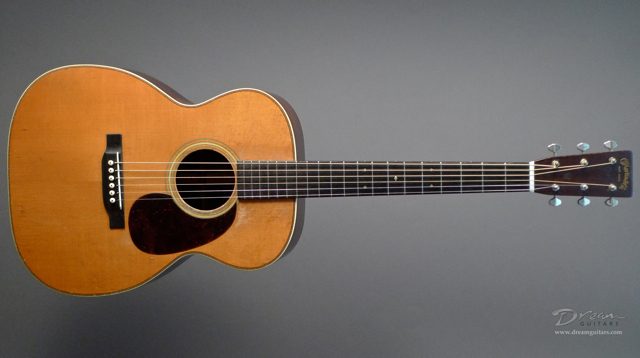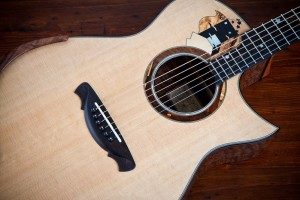
Kathy
Kathy Wingert is an artist that has complete control of her medium. I met her for the first time at the most recent guitar festival in Ft. Lauderdale, at the Hard Rock. Her displays are hugely popular at guitar shows — the lines of her instruments are so elegant, the voices of her guitars are so original, the inlay work is beautiful and so…non derivative.
I have a tremendous amount of respect for Kathy’s skills. She is an exceptional luthier, and consistently builds instruments with supreme voices.
First a little biography please. How long have you been a builder? With whom, if anyone, did you study or do repairs? Please tell me about your “ah-ha” moment when you realized luthiery was to be your chosen path.
A tiny little seed got planted during a trip to a guitar shop, the World of Strings. One of the employees showed me a billet of Indian rosewood and proudly proclaimed that he was going to learn to build a guitar. I was very curious about where and how that got done, and he said he would be learning from his boss, Jon Peterson.

My ah-ha came during a moment of soul searching, which I happened to be doing in the library. I was ready for a new chapter and a new direction, the kids had gotten old enough for me to start thinking that way, and I was wide open to new ideas. As luck would have it there was a book on guitar making in my library. (I wish I could say which book it was, I haven’t seen it since.)
Though I knew instantly and deeply that I could be good at guitar making, I also knew it would take a little time to find my path. I was on the cusp of the internet, and back in those days, kids, you had to leave your house to get information. I read my way through five libraries and had collected quite a few books, including books about sharpening chisels and the amazing number of ways a router could be used, but I hadn’t found in print the book that made it all make sense. I really don’t know how long the discovery process went on, but one morning I woke up and I understood how to build a guitar, not from a plan, but from a design of my own.
The next hurdle was finding materials. A kind employee of a woodworking store told me about a guitar making class at a community college, and after I had been in the class for two months, the instructor told me that Jon Peterson at the World of Strings was looking for someone. I took in some necks I had carved and an electric drop top that I had completed and got hired in 1995.
Has being a woman, in a field largely dominated by men, been advantageous or disadvantageous in anyway?
It was annoying as heck in the busy repair shop. If I went to the counter they’d just ask for the “repair guy.” I think being a woman kept my client list a little leaner than some builders with whom I feel I am well matched, but time has sorted a lot of that out. I do know that I have had more than my share of wonderful customers with whom I have enjoyed every part of the journey.
On your website, you mention that you are in love with your job, and how deeply you enjoy the creative aspects of being a builder. Can you tell me more about that emotional connection, and how it relates to building guitars for clients, who may have different preferences than your own?
The answer to that probably relates pretty closely to the issue of being a woman in a male dominated business. I think many times the people I work with are just open to letting me do what I do. I can tell you for sure guys have let me build some pretty frilly guitars for them while pretending it was my idea!
Look, I’m very invested in what I do, and I am emotionally connected, but I’m also 100 percent pro. There is almost always a middle ground, and I can catch the vision even if a client’s tastes are different from mine.
Working with your daughter Jimmi must certainly add to the love and meaningfulness of designing and constructing your instruments. How does that collaboration work? How much free reign do you allow her to incorporate her own ideas?
Jimmi just continues to get better and better busier and busier, so I’m loving what’s going out the door to other builders, and I stare meaningfully in her direction hoping she will have time for me again one day!
Jimmi works with me much the same way as she works with any builder. A lot of the time she works directly with the client and then construction issues are sorted out with the builder. When we’re working on one of mine we have the advantage of passing materials back and forth, but she works it out really well by mail too.
When someone calls you to commission a guitar, how does the communication process work? How do you discover what type of guitar to build for a client that has difficulty articulating how they’d like the
 instrument to be voiced?
instrument to be voiced?
Sometimes it’s a matter of discovering how much a potential buyer might know about the subject of tone and wood differences. If it’s an experienced collector I ask a few questions about what they like and/or don’t like about guitars that they’ve owned. I always look for that little area of common experience and we work from there. If it’s a less experienced guitarist or guitar buyer, I look for the same thing, but perhaps instead of talking about whether they like the punch of sitka or the twinkle of koa, I might ask a lot of questions about voices of singers or instruments in an orchestra. The point, for me, is to find out whether they are looking for a guitar like mine. Occasionally I have suggested other builders when I’ve felt there would be a better match up.
Speaking of voicing, please take me through the process of voicing a guitar with a contemporary sound, and how that differs from voicing a guitar that is more traditional.
I don’t know if I’m qualified to answer that one. My work has been toward a sound that I wanted to hear, and I have learned through hard lessons what takes me away from that. I have all the same anecdotal information about what makes a prewar Martin sound like they do, but I have never pursued that sound.
You have mentioned using a signal generator and Chladni patterns in voicing your guitars? Could you describe what Chladni patterns are and how you use them to help in the process?
When you play a harmonic on a string, you have divided it in segments, but the reason it physically works is because at the mathematical division of the octave or fifth or whatever, there is a nodal point on the string that allows it to vibrate freely around a still point when the conditions are right (meaning when the string is struck and your finger is on that node). At those naturally occurring places, there is no displacement. When a guitar top is excited with vibrations, there are also nodal points and in those areas of little to no displacement, the glitter piles up.
The arrangement of the glitter patterns at a given frequency range indicates the efficiency of the top, or more instructively, the non-appearance of a pattern at a target frequency means I have work to do.
Chladni patterns are not a recipe for a great guitar, they are an indication of what you just did. Hopefully, if you stumble on a great recipe, you can do it again.
I am not an expert on Chladni patterns or any other science approach to lutherie, so my use of glitter testing is merely a way to double check that I’m on the right track. The range of frequency at which I get certain patterns are what I’m interested in, and the rest I do the old fashioned way.
The first Kathy Wingert guitar that I had the pleasure of playing had back and sides of blackwood. It immediately became my favorite tone wood, even passing Brazilian Rosewood as my tone wood of choice. Please tell me about working with blackwood, how you view its tonal characteristics, and when you would recommend it over Brazilian.
I love AB, but I’ve come to hear it very differently from Brazilian, and for a long time I wouldn’t have said that. What I like and what I hear in the heavy woods, AB and cocobolo is a weightiness and sustain in the mids. If you try to hold me to a blindfold A/B test, I’ll be happy to tell you that I learned a long time ago it’s darned hard to do! I believe that 90% of tonewood choice has to do with the feedback the player gets and has very very little effect on the listener 15 feet away, at least not if there is any other noise in the room.
How important are trade shows and guitar festivals for bringing in new clients and expanding the growth of your business?
I think the trade shows and festivals are enormously important for custom lutherie as a whole. I know I personally benefit from doing them, though many times it is long after the show. I always see or hear something the kicks my fanny. I also believe it’s really important for the community as a whole to show up, present well, and let people know that we are accountable to a larger community. As a community, professional luthiers have built a lot of trust. We have buyers who write checks for a deposit on something they aren’t going to see for years. That’s huge.
You seem very environmentally aware. How can the traditions of luthiery evolve to embrace a new “greener” philosophy?

I might be wrong, but I think small builders working on a few instruments are remarkably green. We waste as little as possible and most of us don’t do a lot clothes or shoe shopping for this career. Many of us commute only a few steps from the house to the shop.
I am going to guess that the nastiest thing we do is over use abrasives. I love working with planes and drawknives, but I have power tools and it just goes faster. If I were to grab for that knife, the dust collector could stay quiet.
As for the protection of exotic hardwoods, it’s important to care, and it’s important to stop asking for woods that are in trouble from places that are over harvested. The highest and best use of precious exotic woods is in fine instruments, and some of the controls that are in place should go a long way toward stopping the indiscriminate use of fine woods on not so fine factory instruments, or as flooring or lawn furniture. It’s also important to understand that the trees won’t be protected if they have no commercial value, so it is important as a community that we fight for the woods that we need. For those who are somewhat new to the subject, please re-read that last line!
Please tell me about your fascination with Harp Guitars?
That was a case of a customer wanting something I didn’t really want to do. In fact, I refused for more than a year. But the customer was a friend and he has patience, so he wore me down. After I built one and had a minute or two to try to play one, I was interested in building more, if only for my own use. I haven’t been able to hang on to one long enough to learn much, and what I do work out on one is easily forgotten, but harp guitars aren’t meant to make guitar playing harder, they are meant to make it easier once you get a toe hold. The jumping off place is a lot more difficult on harp guitar, and I’m still there.
Some of your larger harp guitars have sycamore back and sides. Why sycamore? Tonally, what does this wood offer?
Some of my harp guitars are sycamore because I had it! Harp guitar sets are hard to come by and I thought it would look cool. It was very successful for harp guitar because it didn’t add a lot of clutter to the bass. The bass was clear and strong, but not ringy. The first thing you have to learn is to find the sub basses on a harp guitar, the second thing you have to do is shut them up. I haven’t built a standard six out of sycamore, so my experience with it is limited to the outcome of those two harp guitars.

When I play your guitars, I am always impressed with the strength of the treble frequencies all the way up the neck, and how well balanced they are with the lows and mids. What is the secret to building an acoustic guitar that has such strong treble fundamentals?
Thank you! Again, I can only tell you that my recipe has been added to over time. I tease that it used to take me 120 hours to build a guitar and now I’m pretty sure it takes me twice that long. There are all the added steps that I have acquired over the years.
I think one of the big secrets in guitar building, and one that gets talked about very little has to do with how well the neck tunes to the body. I’m really lucky that my steel string headstock seems to be about the right size and weight. I have nodal points that fall pretty much where I need them to be, and that little extra adds to consistency up the neck – or so my violin making mentor taught me.
In the next 5-10 years, what do you envision for Wingert Guitars? Will there be a continuing evolution in your designs? Will you branch off in new directions?
I have been working on something old rather than something new. I love classical guitar and I have started taking time to pursue that. I’ve built some passable classicals and have sold them at fair prices for their abilities, but I am ready to take commissions on classical guitars now for the right buyers. By the time this goes to print, I will probably have had time to prototype the last couple of things I want to iron out.
I’ve learned over the last couple of years that I really enjoy teaching, but my personal evolution isn’t complete yet. So much of what I do is intuitive or ingrained, it is hard for me to break it down for someone else, so in the next few years, I would like to get better at that kind of communication. I think it might be so appealing because it is at a completely different pace from the daily madness of wearing all the hats. To explain the steps to someone else simply requires taking a deep breath, and that’s kinda nice.
Finally Kathy, do you have any additional thoughts that you’d like to share with our readers, i.e., thoughts about guitars, information about you, thoughts about creativity, life lessons… anything?
Well, all of your readers need a Wingert guitar because they know lots of songs, will entice your creative muse to show up, and will even improve your singing voice in just 14 days!
My great thanks to Kathy for her participation in this interview. Dream Guitars is proud to carry her uniquely voiced one of a kind creations.
Steven Dembroski


































 demonstration
demonstration








































































